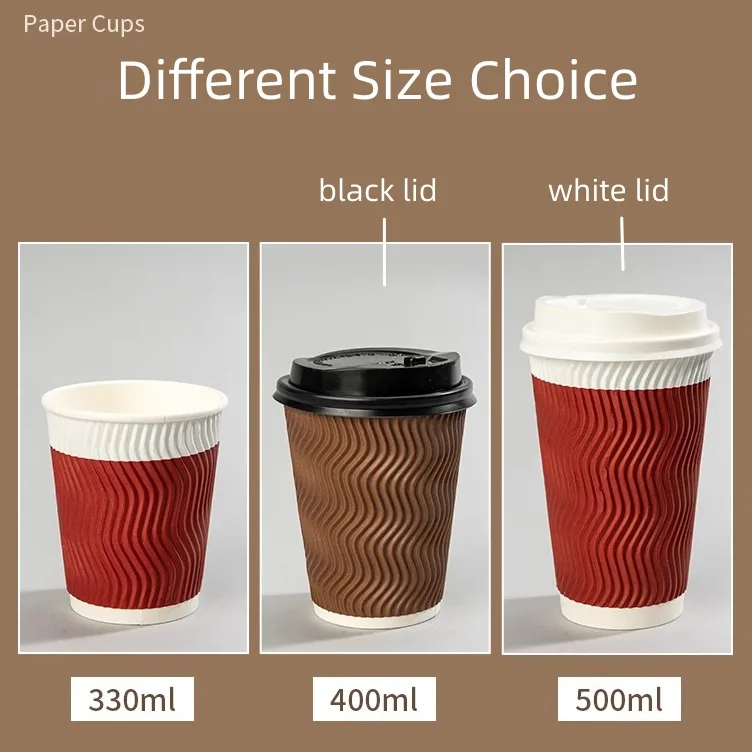Why Paper Cup Size Shapes Customer Experience More Than You Think
Introduction: More Than Just a Cup—It’s a Customer Touchpoint
When a customer picks up their coffee, smoothie, or tea, their first interaction isn’t with the drink—it’s with the cup. Its size, feel, insulation, and look all send a message: convenience, care, quality… or wastefulness.
In 2025, where sustainability and experience are central to every purchasing decision, choosing the right paper cup size is no longer just a logistics matter. It’s a brand strategy.
The Psychology Behind Size: Perception Is Everything
Customers don’t measure ounces—they feel them.
-
A cappuccino in a cup that’s too big feels underfilled
-
A smoothie in an oversized 24oz cup looks watered-down
-
A tea in a 10oz compostable cup feels intentional, warm, premium
Size influences perceived value, beverage quality, and even taste. And when paired with eco-friendly materials like bagasse or PLA-lined paper, it tells a deeper story: your brand values people and the planet.
Paper Cup Size and the Emotion of “Enough”
Studies show that people often use visual cues to determine satisfaction, especially with food and beverages. That’s why:
-
A well-fitted cup gives a sense of completion
-
A half-empty cup (even if full in volume) leaves users feeling short-changed
-
Overfilled cups can create spillage anxiety and ruin the experience
Smart brands now focus on “just right” sizing, using cup proportions that look full, feel good, and align with drink type.
Aligning Drink Type with Paper Cup Size for User Delight
| Drink Type | Ideal Cup Size | Why It Works |
|---|---|---|
| Espresso shot | 4 oz | Tight, cozy, zero-waste, artisan appeal |
| Flat white / cortado | 6 oz | Strong and smooth in hand-sized cup |
| Regular coffee / tea | 8–10 oz | Comfortably full without excess volume |
| Cappuccino / latte | 12 oz | Global favorite, optimal for heat and foam |
| Iced beverages | 16 oz | Good volume with room for ice + lid |
| Smoothies / milk tea | 20–24 oz | Best for cold, thick drinks with compostable dome lids |
The Eco Advantage: Size as a Sustainability Signal
When you choose the right cup size—not too big, not too small—you also reduce:
-
Raw material use
-
Accessory needs (sleeves, double-cups)
-
Transport volume and packaging footprint
Using compostable materials for each size adds another layer of impact:
-
Bagasse (sugarcane pulp) for 4–8oz cups
-
PLA-lined kraft for 10–12oz hot drinks cups
-
Molded fiber with CPLA lids for cold 16–24oz cups
This communicates that your brand cares not just about aesthetics, but lifecycle impact.
Case Example: A Boutique Café’s Customer-Centric Cup Upgrade
A boutique coffee shop in Vancouver redesigned its cup lineup:
-
Switched from 10/16/20oz to 8/12/16oz Paper cup
-
Used 100% compostable bagasse and PLA materials cups
-
Updated signage: “Right Cup. Right Portion. No Waste.”
Results within 3 months:
-
21% decrease in material usage
-
18% increase in positive reviews mentioning packaging
-
Higher tip averages (customers linked the effort to care and service)
-
2 local press mentions for eco-innovation
Paper Cup Size Affects Speed and Service, Too
Baristas and staff appreciate intuitive sizing. Here's how:
-
Fewer cup types = faster training
-
Right fit = less double-cupping and fewer spills
-
Uniform sizing = streamlined shelf organization
Plus, compostable cups designed for specific sizes are lighter, nest better, and support high-volume service.
Tips to Improve Customer Experience Through Smart Sizing
-
Run a size audit: Compare real drink volumes to current cup sizes
-
Use visual fill guides: Help staff pour the right amounts
-
Simplify your lineup: Aim for 2–4 core sizes that fit all use cases
-
Use customer feedback: Ask which sizes feel right, not just taste right
-
Make sustainability visible: Print cup size and compostability info directly on the cup
Future Trends: From Functional to Emotional Packaging
The next wave of paper cup design will combine form, function, and feeling:
-
Temperature-smart materials: Adapt to the drink automatically
-
Shape-based ergonomics: Better hand grip, less lid popping
-
Eco branding zones: QR codes that tell your sustainability story
-
Emotive messaging: “You chose 12oz—saved 15g of paper today!”
As Gen Z and eco-conscious Millennials continue to dominate consumer trends, brands that take paper cup size seriously will lead the next evolution of food packaging.
Conclusion: Every Sip Starts with the Right Size
Paper cup size isn’t just about holding liquid. It’s a conversation between your brand and your customer—about comfort, quality, and care.
When you choose the right cup size and pair it with compostable materials, you deliver more than a drink. You deliver trust. You deliver alignment with values. And you create an experience they’ll remember—and share.
So next time you place a cup order, remember: size matters. Sustainability matters. And together, they create the future of responsible foodservice.


Comments